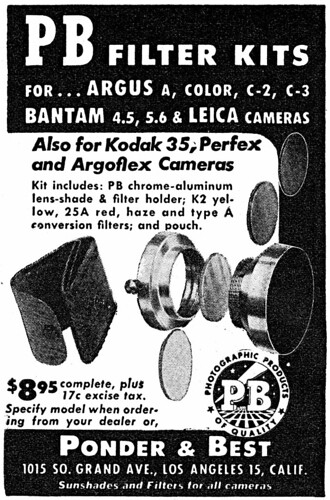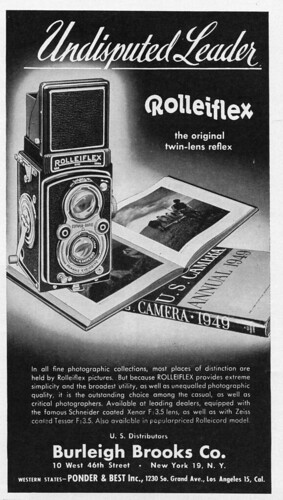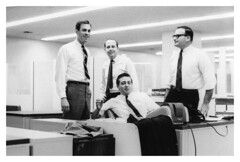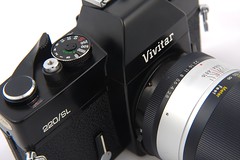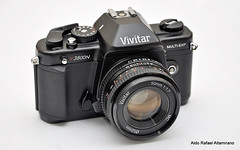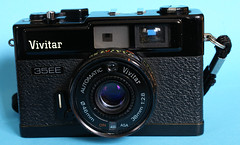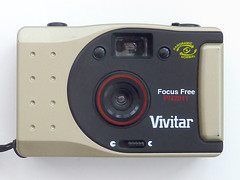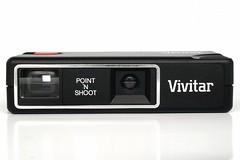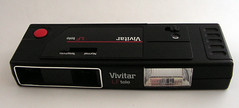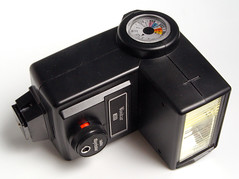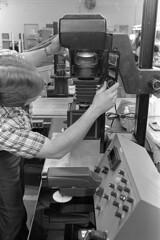Vivitar

|
| Vivitar, perhaps best known as a lens brand image by Chris Lilley (Image rights) |
Vivitar was an American distributor of photographic equipment from 1938-2008. Originally founded under the name Ponder & Best, Inc., the company was established in Santa Monica, California in 1938 as a distributor of photographic products by Max Ponder and John C. Best. Later they began selling rebranded gear under the Vivitar name and eventually began designing and, in a few cases, manufacturing their own Vivitar gear. The company became better known for their very successful Vivitar brand and eventually changed the company name to Vivitar Corporation. The shift to autofocus cameras and later to digital cameras created difficult transitions, leading to a series of mergers, ownership changes, and eventual bankruptcy in 2008. The company itself is gone now but the Vivitar brand was purchased and continues to be used for marketing photographic gear.
Contents
- 1 History
- 2 Cameras
- 3 Vivitar Camera Lenses
- 3.1 Compatible T System Family
- 3.2 Kino Precision Chrome Nose Family
- 3.3 Kino Precision Bright Band Family
- 3.4 Kino Precision Black Metal Ridged-Ring Family
- 3.5 Tokina Metal Ridged-Ring Family
- 3.6 Tokina T-4 Interchangeable Mount Family
- 3.7 Komine Black Metal Ridged-Ring Family
- 3.8 Cosina Diamond Rubber Ring M42 Kit Lens Family
- 3.9 Tokina TX Interchangeable Mount 1st Generation Family
- 3.10 Tokina TX Interchangeable Mount 2nd Generation Family
- 3.11 Cosina XV Kit Lens Family
- 3.12 Komine Diamond Rubber Ring Family
- 3.13 Tokina Diamond Rubber Ring Family
- 3.14 Kino Precision Diamond Rubber Ring Family
- 3.15 Kobori Diamond Rubber Ring Family
- 3.16 Vivitar Autofocus Zoom Family
- 3.17 Other Vivitar Camera Lenses
- 4 Vivitar Professional Camera Lenses
- 5 Vivitar Series I Camera Lenses
- 6 Accessories
- 7 Darkroom Equipment
- 8 Notes
- 9 Bibliography
- 10 Links
History
| ||
| ||
|
Originally founded as Ponder & Best, Inc., the company was established in Santa Monica, California in 1938[1] as a distributor of photographic products by the German immigrants Max Ponder (b. 18 Dec 1907, d. Jan 1969[2]) and John C. Best.[3] Ponder and Best fled to the United States from Germany after Hitler rose to power.[4] The pair started out selling photographic equipment from a 1936 Oldsmobile[1]. Best wrote invoices from the back seat while Ponder acted as the saleman and retrieved merchandise from the trunk.[5]
In the 1940s through at least 1946, Ponder & Best was located at 1015 S. Grand Ave., Los Angeles, CA 90015.[6] Advertising from November 1949 indicates P&B moved or expanded to an adjacent location at 1230 S. Grand Ave. The buildings at these two location no longer exist, only a vacant lot remains as of 2012.[7]
Initially, Ponder & Best pursued relationships with major camera equipment manufacturers including Mamiya[8], Olympus, Rollei, Voightlander, Sawyers, Petri and others[1], becoming the United States distributor for companies in Japan and Germany. But in 1964[1], after losing Rollei and Olympus distribution rights, Ponder & Best decided to come up with their own brand and rebadge the equipment they sold.[9]
They chose Vivitar as their brand name. While the majority equipment bore the "Vivitar" name alone, several variants were also used over the years: the earliest lenses bear the label "P & B Vivitar". A small number of lenses custom-developed for specific customers were labelled "Vivitar Professional", occasionally special edition equipment bore labels such as "Vivitar RL Edition", "Vivitar SMS", or "Vivitar DL". The most well known variant is "Vivitar Series 1" a badge created for the highest end equipment (though after the 2008 dissolution of the company, the "Vivitar Series 1" label began to be used interchangeably with the plain "Vivitar" badging). Ponder & Best filed for the Vivitar trademark on 21 September, 1965. The application states that the name Vivitar was first used in commerce in November of 1963.[10]
In the 1960s, Ponder & Best was located at 11201 West Pico Boulevard, Los Angeles, CA 90064.[11]. The building at this location, built in 1947, is still standing and is zoned for retail use.[12] In 1964, they also opened two branch offices, one in New York city and one in Chicago.[1]
From the late 1960s through 1970s, Ponder & Best's success was largely due to their strategy of providing high quality lenses for SLR cameras at prices lower than the major camera manufacturers.[13] By selling lenses in higher volumes, P&B believed they could match the quality of the camera maker's lenses at lower cost. In addition to marketing their own Vivitar badged products, Ponder & Best continued to represent other manufacturers, eventually regaining their position as an Olympus distributor by 1968.[14]
In late 1971, Ponder & Best moved from the Pico Blvd location in LA to 1630 Stewart Street, Santa Monica, CA 90406.[15]. The building at this location is still standing and has since been renovated.[16]
In the early 1970s, Ponder & Best decided on a new strategy for their Vivitar lenses. Up until now, they had selected lenses designed and built by other manufacturers and rebadged them as Vivitar lenses. Now they set out to create designs for high-quality lenses to their own specifications. They would still outsource the manufacture of the lenses to other companies but the designs would be Vivitar's. These new high-quality lenses were badged as Vivitar Series 1 lenses. This new strategy started with three Ponder & Best employees; researchers Gary Eisenberger and Murray Schwartz, and product manager Bill Swinyard.[17] Eventually, Ponder & Best brought in American company OPCON Associates of Standford, CT for the initial Series 1 lens designs.
Founder and chief designer at Opcon was Ellis Betensky, who had previously worked for Perkin-Elmer on projects such as the Sky Lab Zoom Telescope. Due to Betensky's associations with Perkin-Elmer, Opcon was able to access the latest computer technology for use in the Series 1 design work, leading to highly complex optical designs unlike any previous zoom lenses. Betensky originated the idea of altering the air space between lens elements as the focus changed, resulting in close focusing capabilities that far exceed other lens designs of the era.[18]
The corporate name was changed to Vivitar Corp. in 1979 based on the success of its leading brand name.[3] Over the years, Vivitar became a multinational manufacturing and marketing company with subsidiaries in Japan, West Germany, France, Canada, the United Kingdom, the Netherlands, Belgium, and Switzerland.[3].
As an early adopter of outsource and branding techniques, Vivitar ran into early pitfalls. The biggest problem that plagued Vivitar was lack of control over their outsourced manufacturing. Vivitar provided overseas manufacturers with valuable specifications and equipment designs. Sometimes the manufacturers used the equipment designs in ways they were not authorized to including: 1) manufacturing additional units and selling them directly to competing importers as Vivitar badged equipment 2) manufacturing rebadged or slightly modified versions for competing companies 3) manufacturing additional units under the manufacturer's own badging.
Disputes over these issues were responsible for some of Vivitar's shifts from one manufacturer to another. In 1984 Vivitar brought suit against the United States in the Court of International Trade for declining to prevent "third parties" from importing unauthorized Vivitar branded equipment. The US argued that since Vivitar had instructed the manufacturers to put a Vivitar label on the products, they were by definition authorized, regardless of the contractual arrangements (or lack of them) between Vivitar and the manufacturer. Vivitar prevailed in the case but the US appealed and won, meaning that US customs could continue to allow the import of unauthorized Vivitar badged equipment and it would be up to Vivitar to discover and pursue the individual US importers who received the unauthorized goods and file suit against them under other parts of the trademark law.[19]
In 1985, Vivitar was purchased by Australian company, Hanimex Group, a subsidiary of Australian real estate developer, Chase Group. The year before Hanimex took over, Vivitar lost five million US dollars. The year after the takeover Vivitar experienced a four million dollar profit. By 1988 Vivitar has reached 100 million US dollars in annual sales.[20]
In the late 1980s Vivitar introduced self-contained, battery-powered auto-focus lenses. These were fixed mount lenses designed for conventional, non-autofocus SLRs. Mounts available included Canon FD, Pentax K, Nikon AI-S, and others. There were both Vivitar and Vivitar Series 1 branded auto-focus units. The concept was later abandoned, making these lenses relatively rare.
A real estate slump in the late 1980s forced Chase Group to sell several of its business. Vivitar and Hanimex were sold to UK-Based Gestetner PLC (itself owned by Ricoh) in early 1990. In March of 1990, John Bourne was named president of Vivitar.[21] After Gestetner took over, Vivitar shifted it's focus from high-end lenses and flashes, to hand-held, point-and-shoot cameras.[22]
In 1993, Concord Camera Corp, a manufacturer of pocket cameras, attempted to buy Vivitar from Gestetner PLC but was unable to finalize the purchase when increasing financial losses prevented them from coming up with the required cash in time. Concord's President, Victor M. Chernick, was president of Vivitar from 1986 through 1989. At this time Vivitar had 120 employees.[23]
The 1994 Northridge earthquake[24] damaged Vivitar's primary facilities in the San Fernando Valley and caused the loss of product stock. This is said by some to be responsible for the final demise of the Vivitar Series 1 lenses, which were already suffering a decline in sales due to Gestetner's new focus on selling point-and-shoot cameras and Vivitar's decision not to pursue auto-focus technology.[25] Vivitar subsequently moved to Thousand Oak, CA.[26]
On September 30, 1996, Plaza Create Co Ltd of Japan, acquired Vivitar Inc. from Gestetner PLC. In January 1997, President and CEO of Vivitar, Alex Wijnen, announced the company would be split into two divisions: the Photographics and Optics Division, and the Electronics and Digital Imaging Division.[27]
On February 24, 1998 Douglas E. Howe was named president of Vivitar.[28]
The company was bought on November 21, 2006 by Syntax-Brillian Corporation.[29] Two years later on July 8, 2008, Syntax-Brillian filed for bankruptcy. Sakar International acquired the Vivitar brand and intellectual property on August 21, 2008. The deal did not include Vivitar's equipment or facilities.[30] After the sale, Vivitar's assets and product stock were liquidated in a massive online auction that included more than 13,000 digital cameras, camcorders, and other photographic gear.[31] The online auction ended Vivitar's existence as a company after 70 years (1938-2008). The brand name lives on, however, and continues to be used for marketing photographic equipment.
See also:
Cameras
35mm Film Cameras
Interchangeable Lens 35mm Cameras
| ||
|
Listed in order of release date and ascending model number. Lens mount type and manufacturer is listed if known.
- 220/SL - M42 universal screw mount, made by Cosina
- 250/SL - M42 universal screw mount, made by Cosina
- 400/SL - M42 universal screw mount, made by Cosina
- 420/SL - M42 universal screw mount, made by Cosina
- 450/SLD - M42 universal screw mount, made by Cosina
- 650/SLX - M42 universal screw mount, made by Cosina (prototypes only - shown at Photokina 1974, based on Cosina Hi-Lite ECII)
- XC-2 - M42 universal screw mount, made by Cosina
- XC-3 - M42 universal screw mount, made by Cosina
- XC-4 - M42 universal screw mount, made by Cosina
- XV-1 - Pentax K mount, made by Cosina
- XV-2 - Pentax K mount, made by Cosina
- XV-3 - Pentax K mount, made by Cosina
- XV-5 - Pentax K mount (Chinon CM-5?)
- XV-10 - Pentax K mount, made by Cosina
- XV-11 - Pentax K mount (Chinon CM-4s?)
- XV-20 - Pentax K mount, made by Cosina
- V335 - Pentax K mount, made by Cosina
- V635 - Pentax K mount, made by Cosina
- V50 - Minolta MD mount (likely made in China by partner Seagull)
- V60 — Pentax K mount, likely a rebadged Cosina C2
- V2000 - Pentax K mount, made by Cosina
- V3000, V3000s - Pentax K mount, Chinese OEM
- V3000N - Pentax K mount, Chinese OEM
- V3200 - Pentax K mount, Chinese OEM
- V3300se - Pentax K mount, Chinese OEM
- V3600 - Pentax K mount, made by Cosina
- V3800N - Pentax K mount, Chinese OEM
- V4000, V4000s - Pentax K mount, made by Cosina
- VN5000 - Nikon F mount (AI-S), Chinese OEM
- V6000 - Pentax K mount, made by Cosina
Fixed Lens 35mm Cameras
Rangefinders
|
Zone focus
Auto Focus
- 240Z
- 250PZ
- 270PZ
- 280PZ
- 300Z
- 320 Z
- 335 Z
- 335 PZ DB
- 357 PZ Quartz Date
- 457 PZ Quartz Date
- 530 PZ Date-A-Print
- 550PZ Data Back
- 2001Z
- AF255DB Date-A-
- AF450 (AF450DB)
- Vivitar Big View BV35
- BV35DB Big View
- BV65AF
- C35R Auto Focus / Motor / Red-Eye Reduction
- EZ250
- EZ3AF Data-A-Print
- Mega 200
- MV360
- PN919
- PS33BV
- PS60DB Date-A-Print
- PS77 Auto Focus / DX Motor
- PS88
- PS90 Data-A-Print
- PS650DB Date-A-Print
- PS:35
- PS:135
- PS:145
- PZ2370 DB
- PZ2800
- PZ3090 Date-A-Print
- PZ3110 Data Back
- PZ3115 Date-A-Print
- PZ3118
- PZ3125 Quartz Date
- PZ3140
- PZ3815 DB
- PZ3890 DB
- PZ3580 DB
- PZ7000 Quartz Date
- PZ8000
- R-400 Auto Flash Motorized DX
- R-600
- RL 4000
- Series 1 320Z
- Series 1 440PZ
- Series 1 450PZ
- Series 1 460PZ
- Series 1 470PZ Data Back
- Series 1 475PZ Quartz Date
- Series 1 480PZ
- Series 1 500PZ
- Series 1 650PZ DB
- Series 1 PZ3070 Date-A-Print
- Series 1 ZM80
- Series 1 ZM95DB
- ST165
- TEC 45
- TEC 155 with Series 1 Auto Focus Zoom Lens 35mm-79mm f/3.5-6.7
- TL70 Tele Wide
- TL 125 Auto Focus Tele/Wide
- TW 35
- V3500 Data Back
- VP2000
- VP4550
- VP5500 DB Panoramic
- VP5900DB Data Back, Big View/Auto Focus
- VP8000
- WZ28 Power Zoom
- XB200
- ZM5000 Power Zoom
Fixed Focus
| ||
|
- 280 PZ Focus Free Power Zoom
- 35C1 Focus Free
- EF35
- 3Dcam Stereo camera (manufactured by Loreo)
- A35 Splash Proof
- Amphibia underwater camera
- BF-5
- BV40 Focus Free/Motor
- BV50
- Champion 3
- Champion 35, 38mm lens (blue/black and red/black variants)
- Crayola Sport 35
- CV35
- CV40
- DL50
- DM750 Telemotor Focus Free
- ECO35
- ECO35H
- ECOSUN, 34mm lens
- EZ Motor Big View
- EZ Point 'n Shoot Big View
- EZ200
- HC 2000 Focus Free
- IC 100
- IC 101 Panorama (panoramic)
- IC 111 Focus Free
- IC 400
- IC 1200
- J301
- LC600 Focus Free
- LC650 Focus Free
- LI-55
- LP45 Focus Free / Motor
- Opus 35, 34mm lens
- Opus 35 Motor
- PN2011 (panoramic)
- Point'N Shoot 400
- PS 1-2-3 Focus-Free/DX
- PS:5
- PS:10 Focus Free, 38mm lens
- PS12
- PS15, 35mm lens
- PS:20
- PS25
- PS:30
- PS33 Focus Free, 33mm lens
- PS40 Focus Free Data Back
- PS44 Focus Free/DX
- PS44s Focus Free
- PS45PDB Data Print (panoramic)
- PS45s, 28mm lens
- PS50DB Date-A-Print
- PS51P Panorama (panoramic)
- PS55s
- PS:120 Focus Free/DX
- PS:130 Focus Free/Auto Flash
- PS420 (panoramic)
- PZ3052 (panoramic)
- RL 2000 Focus Free/DX
- Spree Free Focus Free / Motor
- Spree Plus Focus Free
- T101 Focus Free, 28mm lens (silver/black and red/black variants)
- T150 Focus Free (panoramic)
- T200 (panoramic)
- T201 lx
- T301
- TL45 Clearcam, 27mm lens
- TL70 Tele Wide Focus Free
- Twin735 Focus Free / Tele-Wide / Motor
- Ultra Compact
- Ultra Wide & Slim
- Viewpoint, 28mm lens
- Vista Tele (panoramic), 35mm/70mm lens
- Vista Tele Motor (panoramic) 35mm/70mm lens
- VP1000 Focus Free / Auto Flash
- WZ28 Focus Free
APS Film Cameras
110 Film Cameras
| ||
|
- 110 Point 'N Shoot
- 110EF
- 110EF Pocket
- 110EF Tele
- 402
- 406
- 600 Point 'N Shoot
- 602 Point 'N Shoot
- Tele 603
- 604 Point 'N Shoot
- 700 Point 'N Shoot
- 702 Point 'N Shoot
- Tele 703 Point 'N Shoot
- 742 XL Point 'N Shoot
- Tele 805 Point 'N Shoot
- 810
- Tele 815 Point 'N Shoot
- 820 Point 'N Shoot
- 830AW Point 'N Shoot
- Tele-835AW Point 'N Shoot
- 840 Motor Point 'N Shoot
- 845 Tele Motor
- L.A. Brites
- LF
- LF tele
- Micro 110
- Opus 10
- Opus 20
- Radio 110
Digital Cameras
|
|
|
|
Super 8mm Film Cine Cameras
- TL3 (ca 1967)
- TL4 (ca 1967)
- TL6 (ca 1967)
- TL268 (ca 1968)
- TL368 (ca 1969)
- TL468 (ca 1968)
- TL398 (ca 1968)
- 83 Super 8mm (ca 1969)
- 84 Super 8mm (ca 1969)
- 84P Super 8mm (ca 1969)
- 85P Super 8mm (ca 1969)
- 88P Super 8mm (ca 1970)
- 94P Super 8mm (ca 1971)
- 94PM (macro) Super 8mm (ca 1971)
- 96P Super 8mm (ca 1971)
- 98P Super 8mm (ca 1971)
- 98PM (macro) Super 8mm (ca 1971)
- 100PM (macro) Super 8mm (ca 1971)
Digital Cine Cameras
|
|
Vivitar Camera Lenses
An attempt has been made to break down the Vivitar lenses by family, that is, a group of lenses that were marketed together for a period of time. The families are listed in roughly chronological order of introduction. While there were exceptions, as a general rule Ponder & Best selected and distributed a family of lenses from a single manufacturer. To complicate things, P&B sometimes marketed several completely different lens families at the same time. Bill Swinyard, P&B product manager explains:
One great lens doesn't make a new product line; and we sold lens lines, not just lenses. That's what our US dealers wanted. Typically, the manufacturer designed and produced the lens and then offered it to us. If we didn't buy sufficient quantities, that same lens was often sold to Soligor or another distributor. Soligor was our biggest competitor at the time. So we always tried to figure out how to sell what we were offered. That led to some very strange product lineups! For example, at the same time we were selling our 90-230 T4 mount, we also had a 75-260 T4, a 85-205 fixed mount, and probably others of similar zoom range. We also had three interchangeable mount lens lines: T-mount (manual aperture setting) and two semi-automatic lines: the T4 and TX, which I was first marketed by Tamron. It seems strange, but followed our business practice of trying to keep these lenses out of the hands of our US competitors. The Japanese were very difficult to deal with, didn't much value our American opinion, and pretty much did what they wanted. If we didn't like it ... well, there was always Soligor ready and waiting. [17] (ed note: both the T-4 and TX lines are known to have been manufactured by Tokina. Bill's reference to Tamron may be mistaken or may refer to lenses in the T Mount line)
P&B had limited control over the appearance and design of lenses, having to work with design changes made by the Japanese manufacturers. They also had to switch manufacturers from time to time depending on what was being offered to them. An important difference between P&B and other rebadged lens distributors of the time, such as Soligor, was P&B's requirement that every lens they distributed go through stringent quality control testing done at P&B, in addition to any quality testing done by the manufacturer. Other distributors tended to rely solely on the manufacturer's quality control measures.
Compatible T System Family

|
| Vivitar Compatible T System Logo (Image rights) |
ca 1964 - 1975
Ponder & Best marketed this family of preset T mount lenses as the Compatible T System[32]. The lenses in this family were made by several different manufacturers. The Type 1 manufacturer has been confirmed to be Tokina by Bill Swinyard, the Ponder & Best Product Manager from 1969-1971.[17] The Type 3 manufacturer is known to be Kino Precision. A few models were still being sold after the switch to a unified serial number system, providing further confirmation of manufactures listed here.
Compatible T System Type 1 (Tokina)
- 35mm f/2.8, 52mm filter size
- 35mm f/3.5, 52mm filter size
- 85mm f/1.8
- Vivitar 135mm f/1.8, 77mm filter size (stock #20-110, rare)[33]
- 135mm f/2.8, 55mm filter size
- 135mm f/3.5
- 200mm f/3.5, 67mm filter size
- 200mm f/3.5, compact version
- 300mm f/5.6, 62mm filter size
- 400mm f/5.6, 82mm filter size
- 500mm f/6.3, 92mm filter size
- 600mm f/8, 87mm filter size
- 800mm f/8, 107mm filter size, original version
- 800mm f/8, improved version with sight
Compatible T System Type 2
The manufacturer of the type 2 T mounts is currently unknown.
- 135mm f/2.8 Type 2, 55mm filter size
- 135mm f/3.5 Type 2, 46mm filter size (ex sn 198139)
- 180mm f/3.5 Type 2, 58mm filter size
Compatible T System Type 3 aka "Pyramid Preset" (Kino Precision)
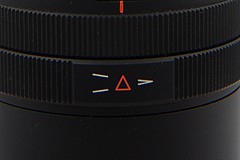
|
| Pyramid Preset mark image by steevithak (Image rights) |
These rare lenses are easily identified by a preset ring marked with a large red triangle, suggesting a pyramid to some collectors. The Pyramid Presets were introduced later the life cycle of the Compatible T System; the earliest printed reference is 1967. At least one model, the 28mm f/2.5 continued to be made in small numbers into the early 1970s and can be found bearing the standardized 22 serial number prefix. The 85-205mm zoom came in 4 variants: two matching the Chrome nose family look, one matching the Bright Band family look and the last matching the more common all-black. All the Type 3 T mounts were made by Kino Precision.
- 28mm f/2.5 Wide-Angle, 62mm filter (rare)
- 28mm f/2.8, 52mm filter size (rare)
- 200mm f/3.5 (rare. Described in P&B print ad as identical to 200mm Chrome Nose. No example has been documented)
- 85-205mm f/3.8 Zoom version 1, 58mm filter (Chrome Nose, rare)
- 85-205mm f/3.8 Zoom version 2, 58mm filter (Chrome Nose)
- 85-205mm f/3.8 Zoom version 3, 58mm filter (Bright Band)
- 85-205mm f/3.8 Zoom version 4, 58mm filter (All Black)
Compatible T System Type 4 (Norita)
The manufacturer of the type 4 T mount is believed to be Japanese lens maker Norita Kogaku K.K. based on the identical appearance of their Norita Noritar 250mm f/4.5 lens. Some collectors refer to this as the Vivitar two window preset lens.[34] Note: evidence suggests this lens was available in both T mount and M42 mount. More documentation is needed on this lens, particularly marketing materials, ads, manuals, or magazine reviews.
Compatible T System Mount Adapters
- TA-1 - M42 Universal Thread, stock #20-9016
- TA-2 - Exakta Topcon C and D series, stock #20-9027
- TA-3 - Nikon F series, stock #20-9038
- TA-4 - Canon FD, FL, TL, and Pellix series, stock #20-9049
- TA-5 - Minolta SR series, stock #20-9050
- TA-6 - Miranda, stock #20-9061
- TA-7 - Konica Auto Reflex series, stock #20-9072
- TA-8 - Konica F series, stock #20-9083
- TA-9 - Petriflex V, 6, 7 and FT series, stock #20-9094
- TA-10 - Leicaflex, stock #20-9108
- TA-11 - Leica Thread mount, stock #20-9119
- TA-12 - Olympus Pen F series, stock #20-9120
- TA-13 - Alpa Reflex, stock #20-9131
- TA-14 - 16mm C mount, stock #20-9142
- TA-16 - Zeiss Contarex, stock #20-9164
Kino Precision Chrome Nose Family
The Chrome Nose lens family was marketed starting in July of 1966 through 1967.[35] Serial numbers pre-date the standardized system that indicates manufacturer but they are believed to have been made by Kino Precision.[36][37]. These are the first automatic, fixed-mount lenses marketed by Vivitar. In addition to the chrome nose, the lenses have an unusual lens coating which gives the glass a distinctive blue tint. The M42 mount is the most common but other variants known to exist are Nikon F and Canon FL mounts.[38] Vivitar ads for some lenses refer only to M42 and Canon, so Nikon F mounts may not have been available on all lenses in this family.[39] The Chrome Nose lenses appear to have been marketed for one year or less and were quickly superseded by the Bright Band family. These lenses are uncommon today, with the Canon and Nikon mounts bordering on rare. They are primarily of interest to collectors since the Bright Band family consists of similar lenses with a variety of functional and optical quality improvements.
- 28mm f/2.8, 52mm filter size
- 35mm f/2.8, 52mm filter size
- 135mm f/2.8, 55mm filter size
- 200mm f/3.5, 62mm filter size
- 85-205mm f/3.8 Zoom, 58mm filter size
Kino Precision Bright Band Family
Marketed ca 1968. With the exception of the Compact 135mm, which was new, these fixed-mount lenses are modified and upgraded versions of the chrome nose family hardware. Serial numbers indicate most members of this family were made by Kino Precision, with the possible exception of the Compact 135mm.
- 28mm f/2.5
- 28mm f/2.8
- 35mm f/2.8
- 135mm f/2.8
- 135mm f/2.8 Compact
- 135mm f/3.5, 52mm filter
- 200mm f/3.5
- 85-205mm f/3.8 Zoom, 58mm filter
Kino Precision Black Metal Ridged-Ring Family
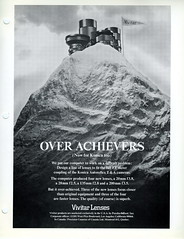
|
| Ad for Kino All-Black Metal Ring Family image by camerawiki (Image rights) |
Marketed ca 1969. Most of these fixed-mount lenses are modified and upgraded versions of the Bright Band family hardware. The primary visual difference is that the bright silver band has been replaced with a black band, leading to a more conventional, all-black design. Lenses in this family were manufactured by Kino Precision. This family of lenses was the first to add fixed mounts for the Konica Autoreflex mount (aka Konica AR mount). Many of the ads for this family tout them as "computer designed" but this is marketing hyperbole. The "computers" were merely early electronic desk calculators used by human lens designers as they made slight modifications to traditional lens designs.[40]
- 20mm f/3.8, 82m filter
- 28mm f/2.5, 62mm filter
- 28mm f/2.8
- 35mm f/2.8
- 135mm f/2.8
- 135mm f/2.8 Compact (unverified)
- 135mm f/3.5
- 200mm f/3.5
- 85-200mm f/3.8 Zoom, 58mm filter
Tokina Metal Ridged-Ring Family
Similar in appearance to the T-4 family which was also manufactured by Tokina and marketed around the same time, these lenses usually have all-black metal design with longitudinal ridges on the focus ring. A few instances are reported with silver trim at the top and bottom of the focus ring like the Tokina T-4 family. These lenses seem to be relatively uncommon compared to the other all-black metal ring families. They are poorly documented, often have slight variations in appearance, and do not show up in P&B marketing materials. There may be additional focal lengths besides those listed below. Any information on these or similar all-metal, non-interchangeable mount Tokina-made Vivitars is appreciated.
- 35mm f/2.8 (both all-black and black with silver trim)
- 100mm f/2.8 (ex sn: 37300833)
- 135mm f/3.5
- 90-230mm f/4.5 Zoom, 58mm filter
Tokina T-4 Interchangeable Mount Family
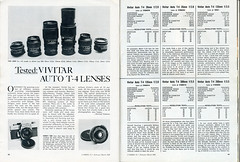
|
| Vivitar T-4 family, 1969 scanned by Nesster (Image rights) |
The T-4 family are lenses with interchangeable mounts marketed ca 1969. Tokina is believed to be the manufacturer,[41] as with the followup TX series.
These lenses have distinctive dual-directional aperture scales, and a small blocky plastic protrusion with "O <—> L" markings used to lock the mount. Later TX-mount lenses (see below) also have these features; but T-4 models are distinguished by focus rings of finely-ribbed metal with chrome edges, and a distance scale (meters) in red. T-4 mount adapters for most common camera mounting types were available; but open-aperture metering had not yet been introduced by several brands such as Canon or Pentax.
Initial production had 9-digit serial numbers beginning 37800… (When 21mm and 105mm were introduced these used 37900… numbering.) Seven-digit serial numbers also exist, including the less common 24mm, and some offer nearer close-focus limits than the original series (it is unclear whether optical formulas also changed during production).
This family of lenses has only slight cosmetic differences from the T4 lenses marketed by Soligor at the same time,[41][42][43] e.g.the Soligor T4 series have bright silver aperture rings, not black. Soligor print materials (and collectors today) mostly omit the hyphen in T-4.
- 21mm f/3.8, 72mm filter (ex S/N: 379000252 - 9 digits)
- 24mm f/2.8 (7-digit serial numbers)
- 28mm f/2.8, 58mm filter
- 35mm f/2.8, 49mm filter
- 105mm f/2.8, 49mm filter (ex S/N: 379001694 - 9 digits)
- 135mm f/2.8, 55mm filter
- 135mm f/3.5, 49mm filter
- 200mm f/3.5, 67mm filter
- 200mm f/3.5 Compact (without tripod foot)
- 250mm f/4.5, 62mm filter
- 300mm f/5.5, 67mm filter
- 400mm f/6.3, 72mm filter
- 55-135mm f/3.5 Zoom, 62mm filter
- 75-260mm f/4.5 Zoom
- 90-230mm f/4.5 Zoom, 58mm filter
Komine Black Metal Ridged-Ring Family
Similar in appearance to the Kino Precision black metal ridged-ring family, these lenses had all-black design with longitudinal ridges on the focus ring. Lenses in this family were manufactured by Komine, based on serial numbers. These lenses were introduced in the early 1970s, likely in 1974 based on advertising.
- 28mm f/2.8
- 35mm f/1.9, 55mm filter
- 135mm f/2.8, 55mm filter
- 200mm f/3.5, 62mm filter
Cosina Diamond Rubber Ring M42 Kit Lens Family
This family of lenses were manufactured by Cosina as kit lenses for the 220/SL through XC-4 line of M42 mount Cosina-made cameras during the 1970s. Only M42 mount versions of these lenses were sold
- 50mm f/1.7 MC, 49mm filter
- 50mm f/1.7 VMC, 49mm filter
- 50mm f/1.8, 49mm filter
- 50mm f/1.9, 49mm filter
- 50mm f/2.8, 49mm filter
- 55mm f/2.1, 49mm filter
- 55mm f/2.8, 49mm filter
Tokina TX Interchangeable Mount 1st Generation Family

|
| Vivitar TX family, 1976 scanned by Voxphoto (Image rights) |
Marketed ca 1976[44][45]. The TX lens family are interchangeable mount lenses that supercede the T-4 series, adding additional metering functionality and new mount brands. They are distinguished from the earlier T-4 designs by an absence of chrome trim at the edges of the focus ring, rubber diamond grips, and a distance scale (meters) in green. The dual aperture markings and locking tab mechanism are unchanged from T-4 lenses. All lenses in this family are believed to be manufactured by Tokina, who is also believed to have designed the TX mount. (While it appears they should fit, TX mount adapters generally will not work on older T-4 lenses.)
- 24mm f/2.8, 58mm filter size
- 28mm f/2.5, 58mm filter size (stock #35-1108)
- 35mm f/2.5, 58mm filter size
- 135mm f/2.5, 58mm filter size
- 200mm f/3.5, 62mm filter size
- 300mm f/5.6
- 400mm f/5.6
- 75-260mm f/4.5 Zoom, 67mm filter size, stock# 35-3102
- 90-230mm f/4.5 Zoom
Tokina TX Interchangeable Mount 2nd Generation Family
Marketed ca 1980 [46][47] These replace some of the original TX family lenses. The fixing ring for the mount adapter is narrower, as is its latch (whose plastic now has a molded O <—> L facing outward). Filter diameters are also reduced. Other 1st generation TX lenses continued to be sold. All lenses in this family are believed to be manufactured by Tokina. These lenses may occasionally be found with "RMC Tokina" branding, with "TXZ" mounting adapters.
- 24mm f/2.8, 52mm filter size
- 28mm f/2.8, 52mm filter size
- 35mm f/2.8, 52mm filter size
- 135mm f/2.8, 52mm filter size
- 200mm f/3.5, 58mm filter size
- 300mm f/5.6, 58mm filter size
- 400mm f/5.6, 72mm filter size
- 35-105mm f/3.5 Close-Focusing Zoom, 72mm filter size
- 70-150mm f/3.8 Close-Focusing Zoom, 52mm filter size
- 80-200mm f/4.0 Zoom, 55mm filter size
- 90-230mm f/4.5 Close-Focusing Zoom, 62mm filter size
- 100-300mm f/5.0 Close-Focusing Zoom, 62mm filter size
Tokina TX Adapters, 2nd Generation
- 0355003 - M42 / Universal Thread
- 0355313 - Nikon F/EL
- 0355324 - Nikon AI
- 0355416 - Canon FL/FD
- 0355519 - Konica Autoreflex
- 0355106 - Pentax ES, Spotmatic F
- 0355612 - Olympus OM
- 0355140 - Pentax K, M
- 0355715 - Mamiya/Sekor SX
- 0355852 - Fujica ST
Cosina XV Kit Lens Family
The XV family of lenses were manufactured by Cosina as kit lenses for the XV line of Cosina-made Pentax K mount SLR cameras during the 1980s. Only Pentax K mount versions of these lenses were sold. Some Vivitar documents say there are 10 XV lenses but only 9 are described in product lists or otherwise documented. The 50mm variants and 135mm are quite common. The others models, especially the 40mm pancake are relatively rare.[48] The XV lenses sold separately from the cameras were packaged in black and white boxes labeled Vivitar XV Lens.
- 28mm f/2.8 VMC, 49mm filter
- 35mm f/2.8 VMC, 49mm filter
- 40mm f/2.5 pancake VMC, 49mm filter (rare)[49]
- 50mm f/2.0 MC, 49mm filter
- 50mm f/1.7 MC, 49mm filter
- 50mm f/1.4 VMC, 49mm filter
- 135mm f/3.5 VMC, 49mm filter
- 200mm f/4.0 VMC, 55mm filter
- 28-50mm f/3.5-4.5 VMC, 55mm filter
Komine Diamond Rubber Ring Family
This the most common and well-known of the Komine lens families made by Vivitar. Some of these lens are extensively documented in the John C. Wolf book, The Vivitar Guide. [50]
- 28mm f/2 Close Focusing Wide Angle, 49mm filter
- 28mm f/2.8 Close Focus Wide Angle, 49mm filter
- 28mm f/2.8 Auto Wide Angle (no MC mark), 49mm filter
- 28mm f/2.8 MC Wide Angle, 49mm filter
- 35mm f/1.9
- 55mm f/2.8 Auto Macro, 62mm filter
- 90mm f/2.8 Macro, 62mm filter
- 135mm f/2.8, 55mm filter
- 135mm f/2.8 Close Focusing, 62mm filter
- 200mm f/3.5, 62mm filter
- 400mm f/5.6, 77mm filter
- 28-50mm f/3.5-4.5 MC Zoom, 58mm filter
- 28-90mm f/2.8-3.5, 67mm filter
- 35-70mm f/2.8-3.8 MC Macro Focusing Zoom, 55mm filter
- 35-70mm f/3.5 MC Zoom, 58mm filter
- 80-200mm f/4.5 Zoom, 58mm filter
- 80-200mm f/4.5 Zoom (silver strip variant)
- 100-200mm f/4 Close Focusing Zoom, 58mm filter
Tokina Diamond Rubber Ring Family
Fixed-mount Tokina-made lenses similar in appeareance to the Komine diamond rubber-ring family. Some of these lens are extensively documented in the John C. Wolf book, The Vivitar Guide. [50].
- 17mm f/3.5, 67mm filter
- 17mm f/3.5 MC Auto Wide, 72mm filter
- 24mm f/2.8, 58mm filter
- 24mm f/2.8, 52mm filter
- 28mm f/2.8, 58mm filter
- 35mm f/2.8, 52mm filter
- 100mm f/2.8, 55mm filter
- 135mm f/2.8, 55mm filter
- 300mm f/5.6, 58mm filter
- 35-105mm f/3.5 Close Range Zoom, 72mm filter
- 75-205 f/3.5-4.5 Macro Focusing Zoom, 55mm filter
- 75-260 f/4.5 Zoom, 67mm filter
- 100-300mm f/5 Close Focusing Zoom, 62mm filter
Kino Precision Diamond Rubber Ring Family
Fixed-mount Kino Precision-made lenses similar in appeareance to the Komine diamond rubber-ring family. Some of these lens are extensively documented in the John C. Wolf book, The Vivitar Guide. [50].
- 24mm f/2 MC Wide Angle, 55mm filter
- 28mm f/2, 55mm filter
- 28mm f/2.5 Auto Wide, 67mm filter
- 90mm f/2.8 MC 1:1 Macro Telephoto, 52mm filter
- 28-85mm f/2.8-3.8 MC Auto Variable Focusing, 67mm filter
- 70-150mm f/3.8 Close Focusing Auto Zoom, 52mm filter
- 75-205mm f/3.5-4.5 Macro Focusing Zoom, 62mm filter
- 75-205mm f/3.8 MC Macro Focusing Zoom, 62mm filter
- 80-200mm f/4.5 Close Focusing Zoom MC (bullet nose), 55mm filter
- 80-205mm f/3.8 Auto Zoom, 58mm filter
- 85-205mm f/3.8 Close Focusing Auto Zoom, 58mm filter
Kobori Diamond Rubber Ring Family
- 28-85mm f/3.5-4.5 Macro Focusing Zoom, 62mm filter
- 28-105mm f/3.5-4.5 Macro Focusing Zoom MC, 72mm filter
- 28-200mm f/3.5-5.3 Macro Focusing Zoom, 72mm filter
- 35-105mm f/3.2-4 MC Macro Focusing Zoom, 55mm filter
- 70-210mm f/4.5 MC Macro Focusing Zoom, 52mm filter
- 70-210mm f/4.5 MC Macro Focusing Zoom, 55mm filter
- Vivitar DL 75-205mm f/3.8-4.8 MC Macro Focusing Zoom, 52mm filter
- 75-300mm f/4.5-5.6 MC Macro Focusing Zoom, 58mm filter
- 75-300mm f/5.6 Close Focusing Zoom MC, 58mm filter
- 80-200mm f/4 Macro Focusing Zoom MC, 55mm filter
- 80-200mm f/4.5 Macro Focusing Zoom, 55mm filter
- 120-600mm f/5.6-8 MC Telephoto Zoom, 82mm filter
Vivitar Autofocus Zoom Family
Marketed briefly starting in 1988, this family was limited to two fixed-mount lenses (though a similar autofocus prime lens was added to the Vivitar Series 1 family). The idea was to make a self-contained, battery-powered autofocus lens that would mount on conventional, non-autofocus cameras.[51]
- 28-70mm f/3.5-4.8 MC Auto Focus Zoom, 52mm filter size
- 75-200mm f/4.5 Auto Focus Zoom, 58mm filter size
Other Vivitar Camera Lenses
These are lenses known to have been marketed by Vivitar but which have not been categorized by lens family yet. In general, if the lens has a metal focusing ring with longitudinal ridges and is all black, it's safe to say it was marketed after the bright band family and before the TX family (ca 1971-1978). If it is all black and has a textured rubber focus ring, it was likely marketed around the time of the TX family or later (ca 1978 or later). Research and serial number collection is ongoing to identify and group these lenses in families by manufacturer.
Primes
- Vivitar 19mm f/2.8
- Vivitar 19mm f/3.8 MC Wide Angle, 62mm filter size
- Vivitar 21mm f/3.8, 67mm filter size
- Vivitar Auto Wide-Angle 28mm f/2.5, 62mm filter size
- Vivitar 55mm f/1.4
- Vivitar 90mm f/2.5
- Vivitar Auto 90mm f/2.5 Macro
- Vivitar 100mm f/3.5 Macro
- Vivitar Auto Telephoto 100mm f/2.8, 55mm filter size
- Vivitar 135mm f/2.5
- Vivitar 200mm f/3
- Vivitar 200mm f/4, 55mm filter size
- Vivitar 500mm f/8 Mirror lens Macro Focusing (marked "Made in Korea")
Zooms
- Vivitar Zoom 28-70mm f/3.5-4
- Vivitar Zoom 28-70mm f/3.5-5.6
- Vivitar Zoom 28-70mm f/3.9-4.8
- Vivitar 28-80mm f/3.5-4.5 Macro Focusing Zoom MC, 62mm filter size (also in RL Edition)
- Vivitar Zoom 28-210mm f/3.5-5.3
- Vivitar 28-210mm f/3.5-5.6 MC Macro Focusing Zoom
- Vivitar Macro-Zoom 28-210mm f/3.5-5.6
- Vivitar 35-70mm 1:3.5-4.8 Macro Focusing Zoom 52mm
- Vivitar 70-150mm f/3.8 Zoom, 55mm filter size
- Vivitar 70-210mm f/4-5.6 zoom
- Vivitar 70-210mm f/4.5 MC Macro Focusing Zoom, 52mm filter size
- Vivitar SMS 70-210mm f/4.5 MC Macro Focusing Zoom, 6 blade iris, 52mm filter size
- Vivitar SMS 70-210mm f/4.5 zoom, 52mm filter size
- Vivitar 75-205mm f/3.8 Close Focusing Auto Zoom, 52mm filter size
- Vivitar 75-205mm f/3.8 Close Focusing Auto Zoom, 58mm filter size
- Vivitar 75-250mm f/3.8-4.5 zoom
- Vivitar 75-260mm f/4.5 Auto Zoom
Tele-Converters
- P&B Vivitar 1.8x Tele Converter Model M-3, Nikon F mount
- P&B Vivitar Auto 2x Tele Converter Model A-1
- P&B Vivitar Auto 2x Tele Converter Model 2A-2, Exakta/Topcon mount
- P&B Vivitar Auto 2x Tele Converter Model 2A-3, Nikon mount
- P&B Vivitar Auto 3x Tele Converter Model 3A-1, M42 mount
- Vivitar 2x macro focusing tele converter MC
- Vivitar Automatic Tele Converter 2x-3 Nikon
- Vivitar Auto 2x Custom Tele Converter 2x-4 FL-FD
- Vivitar Auto 2x Custom Tele Converter 2x-5
- Vivitar Automatic Tele Converter 2x-7
- Vivitar Auto 2x Custom Tele Converter 2x-19 Kodak Retina Reflex (silver)
- Vivitar Automatic Tele Converter 2x-21 Olympus OM
- Vivitar Auto 3x Custom Tele Converter 3x-7 Konica AR
- Vivitar 2x Matched Multiplier for 70-150mm f/3.8 Close Focusing Zoom
- Vivitar 2x Matched Multiplier for 100-200mm f/4 Close Focusing Zoom
- Vivitar 2x Automatic Tele Converter (multiple mounts)
- Vivitar 3x Automatic Tele Converter (multiple mounts)
Vivitar Professional Camera Lenses
Vivitar Professional was a rarely used badge that Ponder & Best applied to lenses they believed would appeal to professional photographers instead of to the consumers and amateur photographers who made up their usual customer base. Only one such lens was ever commercially distributed though at least one other is known to have reached the prototype stage. The badge was used in the late 1960s and was later replaced by the Vivitar Series 1 badge.
Vivitar Series I Camera Lenses
Vivitar Series I fixed mount lenses represent the top-tier products in Vivitar history. Most of were unusual, original designs subcontracted to a variety of lens manufacturers.

|
| Vivitar 600mm f8 Solid Catadioptric Lens image by pointnshoot (Image rights) |
- Series 1 28mm f/1.9 VMC, 58mm filter size (Tokina)
- Series 1 55mm f/1.2 VMC, 58mm filter size, sn 830xxxx, identical to Cosina 55mm f/1.2 [52]
- Series 1 90mm f/2.5 macro with 1:1 optical converter, 58mm filter size (Tokina)
- Series 1 105mm f/2.5 macro 1:1, 52mm filter size (Kino Precision)
- Series 1 135mm f/2.3 Telephoto Lens, 72mm filter size (Komine)
- Series 1 200mm f/3.0 Auto Telephoto, 72mm filter size (Komine)
- Series 1 200mm f/3.5 Auto Focus Telephoto, introduced 1984, 67mm filter size (initially Komine and then taken production taken over by Cosina)
- Series 1 400mm f/4.5 mirror lens
- Series 1 450mm f/4.5 mirror lens
- Series 1 600mm f/8 Solid Cat mirror lens (Perkin-Elmer mfg.)
- Series 1 800mm f/11 Solid Cat mirror lens (Perkin-Elmer mfg.)
- Series 1 19-35mm f/3.5-4.5 (Cosina)
- Series 1 24-48mm f/3.8 Wide Angle Zoom Lens 77mm filter size (Kino Precision)
- Series 1 28-90mm f/2.8-3.2.5 VMC Auto Variable Focusing Zoom 67mm filter size (Komine)
- Series 1 28-105mm f/2.8-3.8 VMC Macro Focusing Zoom, 67mm filter size
- Series 1 28-105mm f/2.8-3.8 Macro Focusing Zoom, 72mm filter size (no VMC mark)
- Series 1 35-85mm f/2.8 VMC Auto Variable Focusing, 72mm filter size (Kino Precision)
- Series 1 70-210mm f/3.5 VMC Macro Focusing Zoom, 67mm filter size (Kino Precision)
- Series 1 70-210mm f/3.5 VMC Macro Focusing Zoom, 62mm filter size (Tokina)
- Series 1 70-210mm f/2.8-4 VMC Macro Focusing Zoom, 62mm filter (Komine)
- Series 1 70-210mm f/2.8-4 VMC Macro Focusing Zoom, 58mm filter size (Cosina)
- Series 1 70-210mm f/2.8-4 Macro Focusing Zoom, Manual Focus, Apochromatic, 62mm filter size (Cosina)
- Series 1 70-210mm f/2.8-4 Macro Focusing Zoom, Auto Focus, Apochromatic, 62mm filter size (Cosina)
- Series 1 70-210mm f/2.8 Zoom, 82mm filter size (Sigma)
- Series 1 90-180mm f/4.5 Flat Field Macro Zoom, 77mm filter (Kino Precision)
- Series 1 100-500mm f/5.6-8 Close Focusing Zoom, 67mm filter size (Cosina)
- Series 1 50th Anniversary Lens Set (Cosina, rare) - A special commemorative set of two lenses made to mark Vivitar's 50th anniversary (1938-1988). The set included gold-plated brass versions of the Series 1 28-105mm f/2.8-3.8 zoom and 70-210mm f/2.8-4.0 zoom, made by Cosina. Each lens included a lens cap with the Vivitar Series 1 logo in gold. A velvet-lined wooden case was included. Only 50 commemorative sets were made in total, or perhaps (less likely) 50 for each of a number of different countries, including USA marked 'Vivitar Corporation', France marked 'Hanimex-Vivitar France', Germany marked 'Hanimex-Vivitar Deutschland Gmbh', and UK marked 'Vivitar United Kingdom Ltd'. The lenses in each set were numbered on the side of the barrel (e.g., "3 of 50") and on the front bezel (e.g., "No.03"). They were never sold to the public but given to Vivitar officials and select dealers. Some sets have passed into the used market where they command high prices from collectors.
Accessories
Extension Tubes and Bellows
- AET-1 Auto Extension Tube for Pentax, Mamiya/Sekor
Flash Units
| ||
|
- 1/70 Electronic Flash (Polaroid flashbar connector)
- 16A Auto Electronic Flash
- 20 Auto SMS
- 28FD Auto Dedicated Thyrister
- 40 Speedlight
- 32 Speedlight
- 40D Auto/Bounced Dedicated Flash
- 44 Speedlight
- 45 Electronic Flash (guide 44, ISO 100/ft)
- 90 Electronic Flash
- 91 Electronic Flash
- 100 Electronic Flash
- 102 Electronic Flash
- 118 Electronic Flash for Kodak 608 and other Instamatic 110 cameras
- 125 Electronic Flash (guide 60, ISO 100/ft)
- 128 Electronic Flash
- 150 Electronic Flash
- 151 Electronic Flash
- 152 Electronic Flash
- 160 Electronic Flash
- 171 Electronic Flash
- 181 Electronic Flash
- 192 Electronic Flash
- 200 Auto Electronic Flash
- 202 Auto Electronic Flash
- 215 Auto Electronic Flash (guide 60, ISO 100/ft)
- 225 Auto Electronic Flash (guide 66, ISO 100/ft)
- 252 Auto Electronic Flash
- 253 Auto Electronic Flash
- 265 Auto Thyristor Flash
- 271 Auto Thyristor Flash
- 272 Auto Thyristor Flash
- 273 Auto Thyristor Flash
- 281 Auto Thyristor Flash
- 283 Auto Thyristor Flash (guide 120, ISO 100/ft)
- 285 Auto Thyristor Flash (guide 120, ISO 100/ft @ normal zoom setting)
- 285HV Auto Zoom Thyristor Flash
- 292 Auto Thyristor Flash
- 352 Auto Thyristor Flash
- 365 Auto Thyristor Flash
- 530FD Auto Thyristor Flash
- 550FD N Auto Thyristor Flash
- 550FD C/R Auto Thyristor Flash
- 550FD M/P/O Auto Thyristor Flash
- 600N Series 1 Electronic Flash
- 626AF Ni Auto Focus Illuminator Flash
- 628AF Auto Focus Illuminator Flash
- 636AF Auto Focus Illuminator Flash
- 728 Auto Focus Flashgun
- 728AFC Auto Focus Zoom
- 730AFNi Auto Focus Zoom Flash
- 836AFM Auto Focus Zoom Flash
- 1900 Electronic Flash
- 2000 Auto Electronic Flash
- 2400M Universal Electronic Flash
- 2500 Zoom Thyristor Flash (guide 80, ISO 100/ft)
- 2600 Auto Thyristor Flash
- 2600 D Auto Thyristor Flash
- 2800 Auto Thyristor Flash
- 2850 RL Edition Flash
- 3500 Zoom Thyristor Flash
- 3700 Auto Thyristor Flash
- 3900 Zoom Auto Thyristor Flash
- 5200 Zoom Thyristor Flash
- 5250 RL Edition Flash
- 5600 Auto Thyristor Flash
- DF-183 (NIK/O/CAN/SON) Digital Bounce Flash
- EZ10 Flash
- SF-4000 Bounce Zoom Slave Flash
- V-1 Flash
Series 1 Flash Units
- Series 1 840 AF Flash
- Series 1 DF-183 AF Bounce Flash
- Series 1 DF-186 Dedicated TTL Flash
- Series 1 DF-383 AF Power Zoom Flash
- Series 1 DF-293 TTL Bounce Flash
- Series 1 PRO-584 LCD Bounce Zoom Swivel Flash
Flash Accessories
- Color/Wide Angle Filter Kit (for 272,273,283,284,365)
- Lens/Filter Adapter (for 283)
- HVP-2 High Voltage Power Pack
Exposure Meters and Light Meters
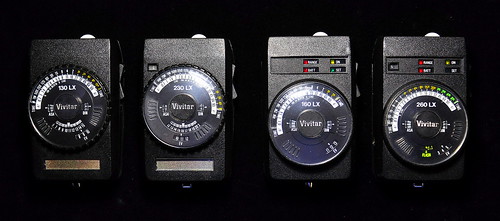
|
| Vivitar LX meters image by Gregory K (Image rights) |
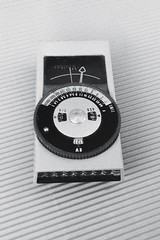
|
| image by Uwe Kulick (Image rights) |
- 23 Hot Shoe Light Meter
- 24 Hot Shoe Light Meter
- 30 Exposure Meter
- 35 Exposure Meter
- 43 Exposure Meter
- 45 Exposure Meter
- 130LX Exposure Meter (aka Digital System Meter)
- 160LX Exposure Meter (aka Digital System Meter)
- 230LX Exposure Meter (aka Digital System Meter)
- 260LX Exposure Meter (aka Digital System Meter)
- Electronic Flash Meter (EFM), aka Electronic Flash Computer
- Electronic Flash Meter 2 (EFM-2)
Slide Projectors and Printers
- 2000AF Auto Focus Slide Projector
- 3000AF Auto Focus Slide Projector
- 5000AF Auto Focus Slide Projector
- Instant Slide Printer
Telescopic Lens Attachments
These are optical converters with an eyepiece, which attach to the back of a camera lens and allow the user to look through the lens as if it were a spotting scope. The eyepiece includes a prism to turn the image the right way up.
- TLA-1 N/AI Nikon F mount, M/MD Minolta MD mount, O/OM Olympus OM mount
Tripods
- Model 99 "Pocket tripod"
- Model 900 mini tripod with dual cold shoes
- Model 901
- Model 904
- Model 911
- Model 914
- Model 924 ground level tripod
- Model 928
- Model 1000
- Model 1102
- Model 1301
- Model 2200
- Video 100 Tripod with optional tripod dolly
- VPT-120SE
- VPT-120
- VPT-240
- VPT-360
- VPT-1240
- VPT-1250
- VPT-1252
- VPT-2200
- VPT-2320
- VPT-2400
- VPT-2457
- VPT-2650
- VPT-3600
- VPT-3662
- VPT-4867
- VPT-5660
- VPT-6072
- VPT-9675
- VT-41
- V3000
Darkroom Equipment
| ||
|
Vivitar Enlargers
- Enlarger E-32 (aka "Little Grabber")
- Enlarger E-33
- Enlarger E-34 (aka "Little Grabber")
- Enlarger J-35 (marked "made in Japan", black/yellow manual, include lens in blue/grey/black box)
- Enlarger E-36
- Enlarger E-54 (aka "Son of Grabber")
- Enlarger E-74 (aka "The Grabber")
- VI Photo Enlarger
- 356 Dichroic Enlarger
Enlarging Lenses
- 50mm f/3.5 P&B Anastigmat enlarging lens
- 75mm f/3.5 P&B Anastigmat enlarging lens (marked Made in Japan, Zebra stripe barrel)
- 150mm f/4.5 P&B Anastigmat enlarging lens
- 35mm f/3.5 Anastigmat enlarging lens (marked Made in Japan)
- 40mm f/2.8 Anastigmat enlarging lens (marked Made in Japan)
- 50mm f/3.5 Anastigmat enlarging lens (marked Made in Japan)
- 75mm f/3.5 Anastigmat enlarging lens (marked Made in Japan)
- 135mm f/4.5 Anastigmat enlarging lens (marked Made in Japan, sn 34xxx)
- 150mm f/4.5 Anastigmat enlarging lens (marked Made in Japan)
- 35mm f/3.5 enlarging lens (marked Made in Japan, black barrel)
- 40mm f/2.8 enlarging lens (marked Made in Japan, black barrel, sn 47xxx)
- 50mm f/3.5 enlarging lens (marked Made in Japan)
- 75mm f/3.5 enlarging lens, stock 67-7570 same as LU variant below (marked Made in Japan, silver nose, sn 69xxx)
- 90mm f/4.5 enlarging lens (marked Made in Japan)
- 105mm f/4.5 enlarging lens (marked Made in Japan)
- 135mm f/4.5 enlarging lens (marked Made in Japan, black barrel, sn 89xxx)
- 150mm f/4.5 enlarging lens (marked Made in Japan)
- 75mm f/3.5 enlarging lens (no country of origin, Zebra stripe barrel, sn 13xxxx)
- 50mm f/3.5 Vivitar-EL enlarging lens (sn 2200xxxx)
- 50mm f/3.5 Vivitar-LU enlarging lens, stock 67-7536 (marked Made in Japan, silver nose, sn 10xxx, 29xxx, 33xxx, 37xxx)
- 75mm f/3.5 Vivitar-LU enlarging lens, stock 67-7570 (marked Made in Japan, silver nose, sn 39xxx, 64xxx, 72xxx)
- VHE 50mm f/2.8 enlarging lens (marked made by Germany, sn 13xxxxxx)
- VHE 80mm f/5.6 enlarging lens (marked made by Germany)
- VHE 100mm f/5.6 enlarging lens, stock 67-4203 (marked made by Germany)
- VHE 135mm f/5.6 enlarging lens (marked made by Germany)
- VHE 150mm f/5.6 enlarging lens (marked made by Germany)
Darkroom Accessories
- 4-IN-1 Enlarger Easel
- 4 inch lens plate blank
- 8 x 10 inch Developing Trays, 3 pack
- Developing Tank with Adjustable Reel
- Developing Tank with Two Adjustable Reels
- TC-116 Power Supply
- Thermometers
- Siphon for paper washing
- etc.
Notes
- ↑ 1.0 1.1 1.2 1.3 1.4 Vivitar website ca 1998 via the Internet Archive
- ↑ US Social Security Death Index
- ↑ 3.0 3.1 3.2 Company outline of the Vivitar UK website (Web Archive version, 31 May 2007).
- ↑ Yet Another Buyer Sets its Sights on Vivitar
- ↑ Vivitar Clicking Away at 50
- ↑ P&B Ad, Popular Photography, June, 1946, p.164
- ↑ Google Maps view of 1015 S. Grand Ave., Los Angeles, CA 90015
- ↑ Ponder & Best Mamiya ad, May 1965, Popular Photography
- ↑ International Marketing: Strategy and Theory, by Sak Onkvisit and John J. Shaw, Page 386
- ↑ Ponder & Best 1965 trademark application for Vivitar
- ↑ P&B Ad ca 1969
- ↑ Google Maps view of 11201 West Pico Blvd, Los Angeles, CA 90064
- ↑ Vivitar Clicking Away at 50
- ↑ See a January, 1968 Modern Photography ad for the Olympus Pen FT (Vol. 32, No. 1; page 49)
- ↑ P&B Ad ca 1972
- ↑ q=1630+Stewart+Street,+Santa+Monica,+CA+90406&hl=en&ll=34.032079,-118.468248&spn=0.002455,0.002135&hnear=1630+Stewart+St,+Santa+Monica,+California+90404&gl=us&t=h&z=19 Google maps view of 1630 Stewart Street, Santa Monica, CA 90406
- ↑ 17.0 17.1 17.2 Personal correspondence between Bill Swinyard and Steve Rainwater, 17 Feb 2012
- ↑ Cult Lenses
- ↑ Hiebert, Timothy H. Parallel Importation in US Trademark Law, Greenwood Press, 1994, P. 114. ISBN 0-313-28956-5
- ↑ Yet Another Buyer Sets its Sights on Vivitar
- ↑ John Bourne named president of Vivitar U.S. operations Los Angelas Times March 27, 1990
- ↑ Yet Another Buyer Sets its Sights on Vivitar
- ↑ Yet Another Buyer Sets its Sights on Vivitar
- ↑ Wikipedia: 1994 Northridge Earthquake
- ↑ MFlenses: Previous Vivitar Techs
- ↑ LA Times: The Road to Recovery: Brick by Brick
- ↑ Vivitar Splits into 2
- ↑ Douglas E. Howe Named President of Vivitar Corp
- ↑ Company history of the Syntax-Brillian website (Web Archive version, 22 August 2007).
- ↑ News release (archived) at the Vivitar website.
- ↑ Camera Maker Vivitar in Massive Kit Sell-Off (archived)
- ↑ Compatible T System packaging
- ↑ Vivitar Preset Lenses, brochure, Ponder & Best, August, 1967, page B-4
- ↑ MFLenses Forum: The rare Vivitar 250mm f/4.5 Pre-Set Lens
- ↑ Based on dates of magazine advertising
- ↑ Vivitar magazine ad, February 1967
- ↑ The Vivitar Chrome Nose Family
- ↑ Vivitar 135mm f/2.8 Chrome Nose ad, 1967
- ↑ Vivitar 28mm f/2.8 Chrome Nose ad, 1967
- ↑ Personal correspondence between Bill Swinyard and Steve Rainwater, 1 Jun 2012
- ↑ 41.0 41.1 The Casual Collector: T4 for Two (archived)
- ↑ Tested: Vivitar Auto T4 Lenses, Camera 35, Feb/Mar 1969
- ↑ Vivitar Automatc T-4 Lens System owner's manual
- ↑ Vivitar Ad, Popular Science magazine, May 1976, Page 43
- ↑ Vivitar TX Lens System Ad
- ↑ Wolf, John C. The Vivitar Guide ISBN 9780871650658
- ↑ Vivitar TX Series lenses: MFLenses
- ↑ Vivitar Photographic Products, Dealer Guide, Fall 1980, Vivitar Corporation
- ↑ formerly shown at thedisposablecamera.com/vivitar-vmc-40mm-f2-5-pancake-lens
- ↑ 50.0 50.1 50.2 Wolf, John C. The Vivitar Guide ISBN 9780871650658
- ↑ Vivitar ad for Autofocus zoom lens family, April 1988 issue, Popular Science
- ↑ MFlenses Forum: Vivitar Series 1 55mm f/1.2
Bibliography
- Wolf, John C. The Vivitar Guide. ISBN 9780871650658.
Links
- Vivitar official website
- Company history of the Syntax-Brillian official website (Web Archive version, 22 August 2007)
- Company outline of the Vivitar UK website (Web Archive version, 31 May 2007)
- Vivitar film camera instruction manuals, PDF, color from OrphanCameras.com
- Vivitar flash unit instruction manuals, PDF format, color from OrphanCameras.com
- Instruction pamphlets on Vivitar multipliers, Vivitar brand lenses warning with Pk-R mounts used on AF Pentax bodies, T4 mounts at Butkus's OrphanCameras.com
- Yahoo! Group: Vivitar Lenses No longer working (archived)
- Flickr Group: Vivitar Lenses (Not Series 1)
- Flickr Group: Vivitar Maniacs
- Who Made that Vivitar Lens? article by Steve Gandy at Cameraquest
- Vivitar Series I by Robert Monaghan at Manual Focus Lenses
- Ellis Betensky page at Society of Photographic Instrumentation Engineers (SPIE) website
- Ollinger's Guide to Photograph Enlargers: Vivitar Enlargers
- Vivitar in Olypedia (German)
